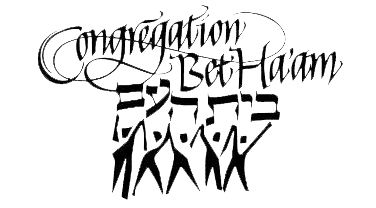by Rabbi Jared H. Saks
Each year, we make our way through the fifty-four portions into which our Torah is divided. At Simchat Torah, the last of our fall holidays, we conclude Deuteronomy and begin Genesis once again. Then, on the first Shabbat after Simchat Torah, we turn to Parashat B’reishit, the first Torah portion, and begin our annual journey once again.
At Bet Ha’am, we have a regular group of students who participate in weekly Torah Study on Saturday mornings at 9:00 a.m. Some have been around the table for over thirty years. Others are only just dipping their toes in the water. Everyone is welcome. We explore each portion through ancient and modern lenses, always asking ourselves the question that a Torah Study regular, Ray Spiro (of blessed memory), used to ask: What does this mean for me today?
This year, Rabbi Saks will be exploring the weekly portions through a new lens, one that is, at least, new to him, and we hope that you’ll join him in the journey. Beginning with Parashat B’reishit on Saturday, October 17, instead of drawing from various sources, we’ll focus our study through the lens of Mussar using The Mussar Torah Commentary: A Spiritual Path to Living a Meaningful and Ethical Life, edited by Rabbi Barry H. Block.
According to an article at MyJewishLearning by Greg Marcus, mussar is “a Jewish spiritual practice that gives concrete instructions on how to live a meaningful and ethical life.… Mussar is virtue-based ethics—based on the idea that by cultivating inner virtues, we improve ourselves. This is contrast to most Jewish ethical teachings, which are rule-based.” The concept of mussar dates back to the time of the Bible. When the term appears in Tanakh (the Hebrew Bible), it carries a connotation of ethical instruction. In the medieval period, it was a branch of study on virtue ethics. The first mussar book was written in 11th century Spain by Rabbi Bahya Ibn Pakudah. By the 19th century, under the leadership of Rabbi Israel Salanter, mussar shifted from an individual practice to a communal tradition. Today, mussar appears in every movement within Judaism.
Whether you are a regular at Torah Study or someone for whom it will be new, we hope you will join us in this exploration. You do not need to own the book because we will read everything aloud. However, you can order a copy here or here (be sure to choose Bet Ha’am’s Smile account) or from your favorite bookseller. We have scholarships available for book purchase—please contact Karen Hindall at karen @ bethaam.org. Regulars, please note: We will not be sending materials in advance while we use this book to guide our study.

